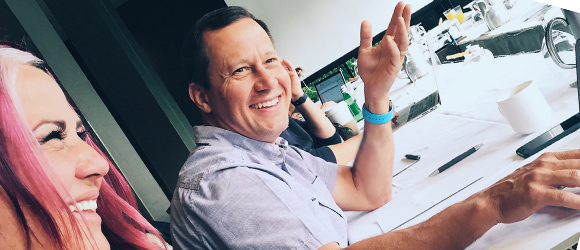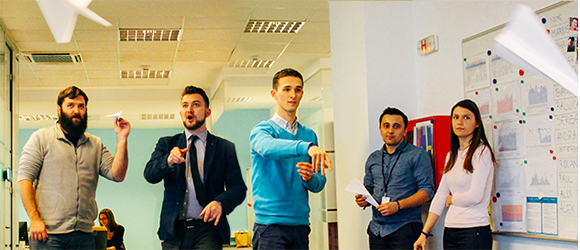Innovate: Encouraging Light Bulb Moments in Your Workplace
We've gathered together some wildly effective yet simple ideas to rev up your capability for innovation and get those creative juices flowing. You'll not only walk away with a fresh viewpoint, but you may be able to turn up the wattage at your very own mental desk.

Think about this. When's the last time you experienced moments of unexpected insight that could be called "a light bulb moment"? Isn't it refreshing and energizing when that happens? While there's no easy way to force these electric ideas to happen, the common denominators to encourage these moments of innovation are people and communication. Using these as a framework, let's check out some high- and low-tech ideas to spark innovation that may surprise you with their simplicity.
Bridging the Creativity Gap
Corporate creativity is directly related to innovation. By isolating the countless causes of corporate 'creativity gaps,' you can play a vital role in boosting innovation. In other words, if deficient creative-thinking skills are to blame for a lack of innovative thought, companies can coach employees to flex their creative muscles and develop more original ideas. And, if the constraints of corporate life are stifling creative endeavors, employers can provide mind-expanding tools and techniques to encourage employees to use their imagination more fully.
As you can probably imagine, free-thinking individuals can keep businesses healthy and fiercely competitive with innovative products, services and ideas. While supporting workers in the quest for innovation may be a new role for management, giving employees an extra little push in the right direction may be all that's needed. So what's causing your own creativity gap? Read on to check out some "innovation legends" that might be influencing you right now.
Busting Some Myths
If you've ever watched the television show "MythBusters," you know that old ideas die hard. One such idea is that of the lone inventor toiling away in the laboratory and eventually hitting pay dirt with a new discovery. This erroneous idea was explored in a business article presented by Drs. Rob Cross, Andrew Hargadon, Salvatore Parise and Robert J. Thomas. These researchers pointed out that "...companies continue to assume that innovation comes from that individual genius, or, at best, small, sequestered teams that vanish from sight and then return with big ideas. But the truth is most innovations are created through networks...groups of people working in concert." So even though "individual genius" is a nostalgic way to look at innovation, the truth is that most of today's original ideas stem from group efforts. So, take it from us...this myth is busted!
Here's another myth that emerges from time to time: small companies can't even begin to compete with the big guys, so they shouldn't even try. Innovation is actually one of the best ways smaller companies can level the playing field to offer more to clients than the corporate giants. In fact, a recent study in the UK presented this surprising information: "...small companies with up to five employees are the best at generating new ideas, with half of them giving staff formal thinking time. In contrast, just 13% of the workforce in large corporations sees their ideas regularly taken up." Is this myth causing your small company's creativity gap? Consider it busted.

I'm sure you've heard this myth before: you need cutting-edge technology to be innovative in today's marketplace. In a recent business article, "A True Story About a Chair," a fantastic idea stemming from a low-tech approach won out corporate disbelievers. With the manager and a couple of chairs and nothing else. Here's how the idea worked:
...[the manager] plopped down two chairs in the heart of this busy corporate campus and put a sign over the two chairs calling out a topic for the day. She occupied one chair and then waited. And waited. And waited for another employee to sit down and discuss the topic she had posted. No technology. No motives. Just a person genuinely interested in her co-worker's thoughts and feelings.... People started to sit and talk. One at a time, [the manager] sat and spoke with employees. Taking notes on employees' concerns and feedback, she promised their input would be anonymously passed on to upper management...and it is.
Can you believe there are long lines of employees waiting to talk with this inventive and open-minded manager? They trust her honesty and aren't bothered at all by the lack of technology or topic to focus on. Spurring employees to innovation can be that simple. It really doesn't even require a chair. What it does require is a willingness to communicate and some free time. So now that we've exposed these outdated beliefs, let's dig in to the real business of "innovation enlightenment" and how to brighten the lights in your own business.

Happy Accidents at Work
When a team of experts from Rensselaer Polytechnic Institute researched some breakthrough innovation projects such as GE's digital X-ray, GM's hybrid vehicles, and DuPont's biodegradable plastics, they discovered most of the ideas came together as the result of "happy accidents" rather than a purposeful quest for a new product or service. Since this haphazard approach is one that many businesses use, it's no surprise 75% of executives questioned in recent worldwide surveys were disappointed by their own company's lack of direction for innovation. A renowned California innovation and product design firm, IDEO, has this take on the creative process: "Fail often to succeed sooner." It's no secret that failures and false starts can pave the way to outstanding inventions. The WD-40 Company, for example, talked to employees and end users to come up with 600 product ideas. The initial list was whittled down to 100 possible concepts and finally to ten leading ideas. In the end, two new products were on the market in less than two years. A whopping 598 product ideas were destined to fail! It's pretty clear that the very ideas destined for your "round file" right now may actually open the door to a unique solution.
How can you structure your business so more of these happy accidents occur? After all, ground-breaking ideas don't emerge from a vacuum. Robert I. Sutton, writing in the Harvard Business Review in 2001, thinks he might know how to encourage innovation. Here's his unusual take: "Hire naive misfits who argue with you; encourage failure; avoid letting client input limit your vision; and fully commit to risky ventures." Even though it sounds wacky and contradictory, he feels this extreme approach to innovation works by mixing things up in the boring and static office environment. Sutton believes that unconventional employees with diverse backgrounds actually work for a company rather than against it. By challenging the status quo, a few well-positioned "misfits" can inject new life into old problems and mindsets. Think of it as the contrarian approach to innovation. But there's more than meets the eye when it comes to innovation approaches. Let's see what the experts say.
Opening Eyes, and Minds, to Innovation
On the following pages, you can read about some of the best ways to set the stage for creative problem solving. Even though the ideas were compiled from companies that specialize in fields other than training, they could just as easily apply to training and development organizations. Take a look for yourself. A host of tools, tips and techniques are available to cultivate employee innovation!
The Approach: Hire individuals with a non-typical background
How it Works: Look for individuals who have a background that's not quite an exact fit for your team. By hiring bright and enthusiastic employees who have "fresh eyes" and may question the status quo, you can rethink current approaches and add to the team's creative potential.
The Approach: Limit your clients' input into projects...or involve customers in new ways
How it Works: According to Robert I. Sutton, ignoring client input may seem counterintuitive, but clients can't always imagine the full extent of what's possible. By involving everyone, even employees not directly involved on a project, and then identifying the best ideas, you'll have a broader view of the problem and may strike gold with a fresh project approach.
If you do involve the customer, look for different methods of involvement. For example, look outside your own field or industry for ideas on how to get input. Automakers, retailers, and consumer electronics manufacturers, for instance, frequently use customer surveys and are often considered the early adopters of innovative techniques.
Consider creating advisory boards of key customers to serve as sounding boards for ideas. Identify customers who tend to buy the latest versions of your products or services. Ask these early adopters to provide insight about where the market may be headed and how your organization can best position itself.
The Approach: Share ideas with coworkers to learn something new
How it Works: Encourage employees to get together frequently to share their best ideas with one another. Create a 'suggestion box' meeting forum where nothing is off limits or not good enough.
The Approach: Swap jobs or take on a project that's out of the realm of your regular work
How it Works: Have employees and managers switch roles every so often just to get a feel for the good (and the bad) about another team's processes and business methodologies. Is there a better way to do things?
There's nothing quite like walking a mile in another employee's shoes to see your own role in a different light. Any effort you make to step out of the realm of your 'regular work' has a benefit. Just pick a period when work demands are lower than usual so a crisis doesn't strike during the job swap.
The Approach: Get out of your comfort zone
How it Works: Try taking a class that pushes your limits to develop new skills. Using your brain in new ways can also help unlock creativity: take a different route to work, eat at a different lunch spot, brush your teeth with your non-dominant hand or put your clothes on in the dark (but check before heading out the door so there are no "wardrobe malfunctions"). Anything novel can stimulate the brain to form new connections.

The Approach: Have fun
How it Works: Facilitate humor, share it and celebrate it. You'd be surprised how many creative doors this may open.
The Approach: Involve everyone at every level of the organization
How it Works: Include more employees in the process of formulating new product and service ideas and in solving organizational problems. Encourage employees to really listen to customers. Listening in on customer support calls is another easy way to get a feel for your customers' mindset.
The Approach: Increase communication and get the right people talking to each other
How it Works: Every company has its share of "information magnets" that need to open up and contribute their knowledge. Figure out what everyone inside the company knows and make sure they talk to people with complementary talents.
The Approach: Reject the "it's not my job" mindset
How it Works: Some employees may have exactly the right range of skills to produce new ideas, but they aren't 'allowed' to innovate because of limited job roles. Make sure worthy ideas aren't rejected just because it's "not their job" to come up with good ideas.
The Approach: Communicate up, across and down
How it Works: Record the milestones along your path to innovation, and keep everyone in the company informed of steps you're taking. Let them know that innovation works best when everyone participates, and continuously encourage communication.
The Approach: Focus on customer needs that they don't always express
How it Works: Learn from customers by observing what they are not doing as well as what they are doing. Along the same lines, listen to what they are not saying as well as what they are saying. Recognize the sources of their frustration and explore potential ways to eliminate it.
The Approach: Seek ideas from new customer groups
How it Works: Look at your customers and your competitors' customers. Instead of looking at only the present, look also at the past (former customers) and the future (potential customers). Ask how you might meet those customers' needs.
The Approach: Involve suppliers in discussions regarding product innovation
How it Works: Just as you look to your customers for new ideas, think of your organization as your supplier's customer. You also have needs. Try to nail down your own needs and then get your supplier's idea-generating capacity working in concert with yours.

The Approach: Think outside the corporate meeting room
How it Works: Use technology wisely to conduct productive meetings from multiple locations. Allow teams to co-locate and create an innovation space that is uniquely theirs. Some companies have designated a special room with an unusual decorating scheme, blog or e-mail listserv designed solely for group idea sharing. Or, considering taking employees outside on a nice day for a little project brainstorming over a picnic lunch.
The Approach: Appoint a CEI (Chief Executive Innovator)
How it Works: Organizations that rely on innovation to build their company need to seriously examine the climate in which idea development takes place and then put someone in charge of creating that climate.
Innovation-adept firms invest in formal innovation sessions, read books, attend seminars, and constantly seek to improve their skills. Your CEI should work with others to identify these opportunities and make them available to everyone in your organization.
The Approach: Tear down the walls
How it Works: Large companies can undermine their innovation efforts by keeping workers isolated from other groups. Take down the visible and invisible barriers that separate groups from one another and don't segregate employees unnecessarily.
The Approach: Consider energy dynamics
How it Works: If you feel positively about a co-worker, you're more likely to turn to him or her for help and advice. Generating ideas together isn't easy, but people who are paired with others they get along with are more likely to share ideas, strengthen connections and contribute positively to the corporate "think tank." Conversely, someone who leaves you feeling drained or irritated can put a damper on innovation.
Ask management to map the energy and enthusiasm in their networks by asking people to identify who leaves them feeling positive and energized.
The Approach: Develop corporate folklore
How it Works: Encourage senior management to tell stories, create an innovation-focused folklore, and actively counteract the 'anti-innovation' syndrome. They can also provide support and tools for the various components of the company to cultivate an innovation-friendly climate.
Do Something Better
As you've seen, innovation isn't a quest to be taken lightly. Companies need to be fully prepared for today's competitive environment, and innovation is one of the best ways to increase the chances of success. A recent article in the Harvard Business Review by Ted Hoff, inventor of the microprocessor, had these words of wisdom: "Don't do what the customer wants; do something better." How's that for innovative thinking?



